Zehan Qi
Tsinghua University
WebRL: Training LLM Web Agents via Self-Evolving Online Curriculum Reinforcement Learning
Nov 04, 2024



Abstract:Large language models (LLMs) have shown remarkable potential as autonomous agents, particularly in web-based tasks. However, existing LLM web agents heavily rely on expensive proprietary LLM APIs, while open LLMs lack the necessary decision-making capabilities. This paper introduces WebRL, a self-evolving online curriculum reinforcement learning framework designed to train high-performance web agents using open LLMs. WebRL addresses three key challenges in building LLM web agents, including the scarcity of training tasks, sparse feedback signals, and policy distribution drift in online learning. Specifically, WebRL incorporates 1) a self-evolving curriculum that generates new tasks from unsuccessful attempts, 2) a robust outcome-supervised reward model (ORM), and 3) adaptive reinforcement learning strategies to ensure consistent improvements. We apply WebRL to transform open Llama-3.1 and GLM-4 models into proficient web agents. On WebArena-Lite, WebRL improves the success rate of Llama-3.1-8B from 4.8% to 42.4%, and from 6.1% to 43% for GLM-4-9B. These open models significantly surpass the performance of GPT-4-Turbo (17.6%) and GPT-4o (13.9%) and outperform previous state-of-the-art web agents trained on open LLMs (AutoWebGLM, 18.2%). Our findings demonstrate WebRL's effectiveness in bridging the gap between open and proprietary LLM-based web agents, paving the way for more accessible and powerful autonomous web interaction systems.
Long$^2$RAG: Evaluating Long-Context & Long-Form Retrieval-Augmented Generation with Key Point Recall
Oct 31, 2024Abstract:Retrieval-augmented generation (RAG) is a promising approach to address the limitations of fixed knowledge in large language models (LLMs). However, current benchmarks for evaluating RAG systems suffer from two key deficiencies: (1) they fail to adequately measure LLMs' capability in handling long-context retrieval due to a lack of datasets that reflect the characteristics of retrieved documents, and (2) they lack a comprehensive evaluation method for assessing LLMs' ability to generate long-form responses that effectively exploits retrieved information. To address these shortcomings, we introduce the Long$^2$RAG benchmark and the Key Point Recall (KPR) metric. Long$^2$RAG comprises 280 questions spanning 10 domains and across 8 question categories, each associated with 5 retrieved documents with an average length of 2,444 words. KPR evaluates the extent to which LLMs incorporate key points extracted from the retrieved documents into their generated responses, providing a more nuanced assessment of their ability to exploit retrieved information.
AutoGLM: Autonomous Foundation Agents for GUIs
Oct 28, 2024



Abstract:We present AutoGLM, a new series in the ChatGLM family, designed to serve as foundation agents for autonomous control of digital devices through Graphical User Interfaces (GUIs). While foundation models excel at acquiring human knowledge, they often struggle with decision-making in dynamic real-world environments, limiting their progress toward artificial general intelligence. This limitation underscores the importance of developing foundation agents capable of learning through autonomous environmental interactions by reinforcing existing models. Focusing on Web Browser and Phone as representative GUI scenarios, we have developed AutoGLM as a practical foundation agent system for real-world GUI interactions. Our approach integrates a comprehensive suite of techniques and infrastructures to create deployable agent systems suitable for user delivery. Through this development, we have derived two key insights: First, the design of an appropriate "intermediate interface" for GUI control is crucial, enabling the separation of planning and grounding behaviors, which require distinct optimization for flexibility and accuracy respectively. Second, we have developed a novel progressive training framework that enables self-evolving online curriculum reinforcement learning for AutoGLM. Our evaluations demonstrate AutoGLM's effectiveness across multiple domains. For web browsing, AutoGLM achieves a 55.2% success rate on VAB-WebArena-Lite (improving to 59.1% with a second attempt) and 96.2% on OpenTable evaluation tasks. In Android device control, AutoGLM attains a 36.2% success rate on AndroidLab (VAB-Mobile) and 89.7% on common tasks in popular Chinese APPs.
VisualAgentBench: Towards Large Multimodal Models as Visual Foundation Agents
Aug 12, 2024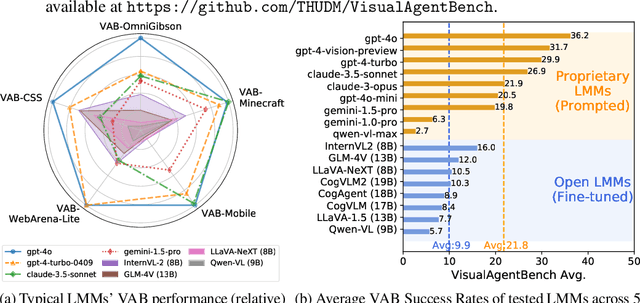
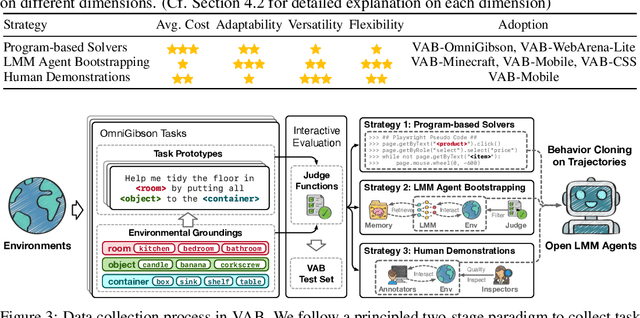

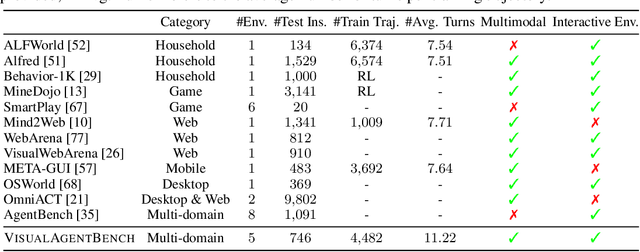
Abstract:Large Multimodal Models (LMMs) have ushered in a new era in artificial intelligence, merging capabilities in both language and vision to form highly capable Visual Foundation Agents. These agents are postulated to excel across a myriad of tasks, potentially approaching general artificial intelligence. However, existing benchmarks fail to sufficiently challenge or showcase the full potential of LMMs in complex, real-world environments. To address this gap, we introduce VisualAgentBench (VAB), a comprehensive and pioneering benchmark specifically designed to train and evaluate LMMs as visual foundation agents across diverse scenarios, including Embodied, Graphical User Interface, and Visual Design, with tasks formulated to probe the depth of LMMs' understanding and interaction capabilities. Through rigorous testing across nine proprietary LMM APIs and eight open models, we demonstrate the considerable yet still developing agent capabilities of these models. Additionally, VAB constructs a trajectory training set constructed through hybrid methods including Program-based Solvers, LMM Agent Bootstrapping, and Human Demonstrations, promoting substantial performance improvements in LMMs through behavior cloning. Our work not only aims to benchmark existing models but also provides a solid foundation for future development into visual foundation agents. Code, train \& test data, and part of fine-tuned open LMMs are available at \url{https://github.com/THUDM/VisualAgentBench}.
DebateQA: Evaluating Question Answering on Debatable Knowledge
Aug 02, 2024



Abstract:The rise of large language models (LLMs) has enabled us to seek answers to inherently debatable questions on LLM chatbots, necessitating a reliable way to evaluate their ability. However, traditional QA benchmarks assume fixed answers are inadequate for this purpose. To address this, we introduce DebateQA, a dataset of 2,941 debatable questions, each accompanied by multiple human-annotated partial answers that capture a variety of perspectives. We develop two metrics: Perspective Diversity, which evaluates the comprehensiveness of perspectives, and Dispute Awareness, which assesses if the LLM acknowledges the question's debatable nature. Experiments demonstrate that both metrics align with human preferences and are stable across different underlying models. Using DebateQA with two metrics, we assess 12 popular LLMs and retrieval-augmented generation methods. Our findings reveal that while LLMs generally excel at recognizing debatable issues, their ability to provide comprehensive answers encompassing diverse perspectives varies considerably.
Walking in Others' Shoes: How Perspective-Taking Guides Large Language Models in Reducing Toxicity and Bias
Jul 22, 2024



Abstract:The common toxicity and societal bias in contents generated by large language models (LLMs) necessitate strategies to reduce harm. Present solutions often demand white-box access to the model or substantial training, which is impractical for cutting-edge commercial LLMs. Moreover, prevailing prompting methods depend on external tool feedback and fail to simultaneously lessen toxicity and bias. Motivated by social psychology principles, we propose a novel strategy named \textbf{perspective-taking prompting (\textsc{PeT})} that inspires LLMs to integrate diverse human perspectives and self-regulate their responses. This self-correction mechanism can significantly diminish toxicity (up to $89\%$) and bias (up to $73\%$) in LLMs' responses. Rigorous evaluations and ablation studies are conducted on two commercial LLMs (ChatGPT and GLM) and three open-source LLMs, revealing \textsc{PeT}'s superiority in producing less harmful responses, outperforming five strong baselines.
MR-BEN: A Comprehensive Meta-Reasoning Benchmark for Large Language Models
Jun 20, 2024
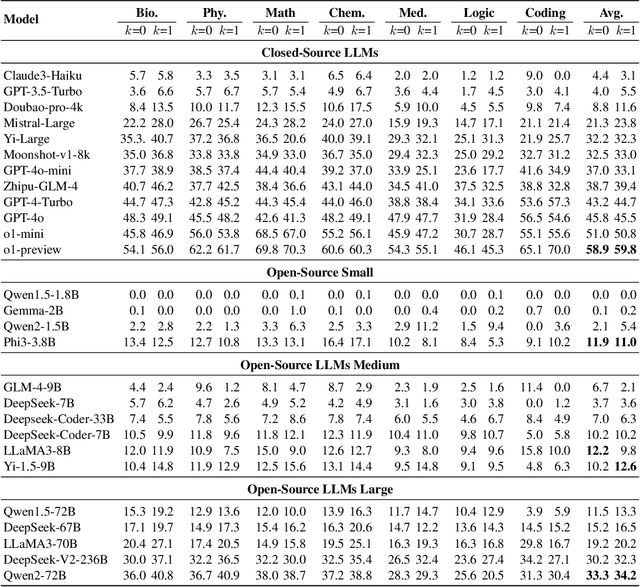
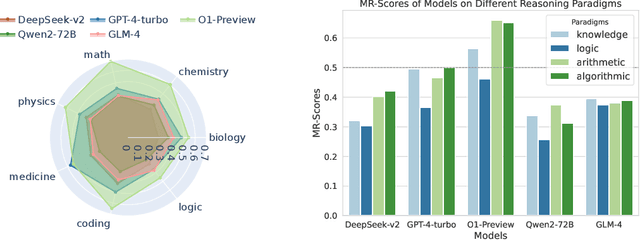

Abstract:Large language models (LLMs) have shown increasing capability in problem-solving and decision-making, largely based on the step-by-step chain-of-thought reasoning processes. However, it has been increasingly challenging to evaluate the reasoning capability of LLMs. Concretely, existing outcome-based benchmarks begin to saturate and become less sufficient to monitor the progress. To this end, we present a process-based benchmark MR-BEN that demands a meta reasoning skill, where LMs are asked to locate and analyse potential errors in automatically generated reasoning steps. MR-BEN is a comprehensive benchmark comprising 5,975 questions collected from human experts, covering various subjects such as physics, chemistry, logic, coding, and more. Through our designed metrics for assessing meta-reasoning on this benchmark, we identify interesting limitations and weaknesses of current LLMs (open-source and closed-source models). For example, open-source models are seemingly comparable to GPT-4 on outcome-based benchmarks, but they lag far behind on our benchmark, revealing the underlying reasoning capability gap between them. Our dataset and codes are available on https://randolph-zeng.github.io/Mr-Ben.github.io/.
ChatGLM: A Family of Large Language Models from GLM-130B to GLM-4 All Tools
Jun 18, 2024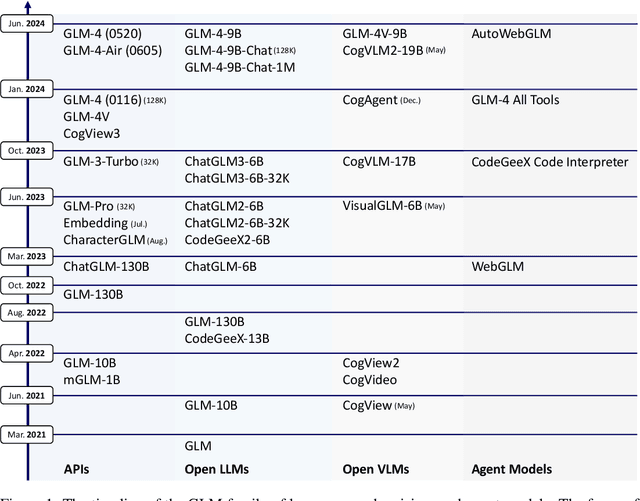
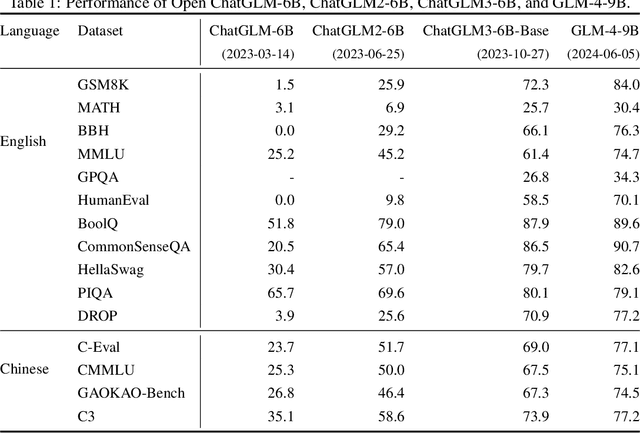
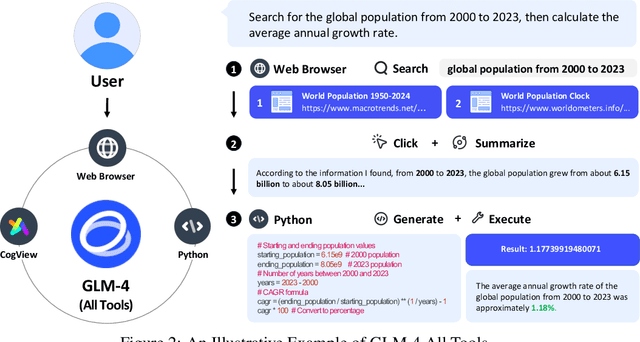
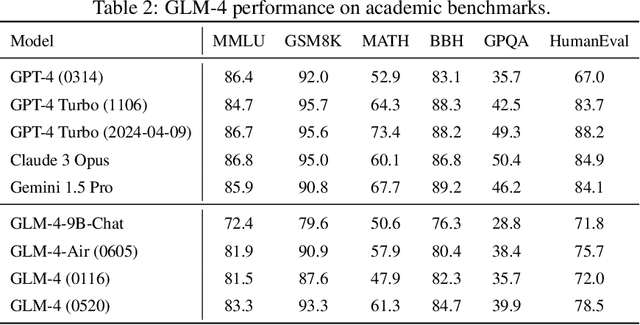
Abstract:We introduce ChatGLM, an evolving family of large language models that we have been developing over time. This report primarily focuses on the GLM-4 language series, which includes GLM-4, GLM-4-Air, and GLM-4-9B. They represent our most capable models that are trained with all the insights and lessons gained from the preceding three generations of ChatGLM. To date, the GLM-4 models are pre-trained on ten trillions of tokens mostly in Chinese and English, along with a small set of corpus from 24 languages, and aligned primarily for Chinese and English usage. The high-quality alignment is achieved via a multi-stage post-training process, which involves supervised fine-tuning and learning from human feedback. Evaluations show that GLM-4 1) closely rivals or outperforms GPT-4 in terms of general metrics such as MMLU, GSM8K, MATH, BBH, GPQA, and HumanEval, 2) gets close to GPT-4-Turbo in instruction following as measured by IFEval, 3) matches GPT-4 Turbo (128K) and Claude 3 for long context tasks, and 4) outperforms GPT-4 in Chinese alignments as measured by AlignBench. The GLM-4 All Tools model is further aligned to understand user intent and autonomously decide when and which tool(s) touse -- including web browser, Python interpreter, text-to-image model, and user-defined functions -- to effectively complete complex tasks. In practical applications, it matches and even surpasses GPT-4 All Tools in tasks like accessing online information via web browsing and solving math problems using Python interpreter. Over the course, we have open-sourced a series of models, including ChatGLM-6B (three generations), GLM-4-9B (128K, 1M), GLM-4V-9B, WebGLM, and CodeGeeX, attracting over 10 million downloads on Hugging face in the year 2023 alone. The open models can be accessed through https://github.com/THUDM and https://huggingface.co/THUDM.
Preemptive Answer "Attacks" on Chain-of-Thought Reasoning
May 31, 2024Abstract:Large language models (LLMs) showcase impressive reasoning capabilities when coupled with Chain-of-Thought (CoT) prompting. However, the robustness of this approach warrants further investigation. In this paper, we introduce a novel scenario termed preemptive answers, where the LLM obtains an answer before engaging in reasoning. This situation can arise inadvertently or induced by malicious users by prompt injection attacks. Experiments reveal that preemptive answers significantly impair the model's reasoning capability across various CoT methods and a broad spectrum of datasets. To bolster the robustness of reasoning, we propose two measures aimed at mitigating this issue to some extent.
NaturalCodeBench: Examining Coding Performance Mismatch on HumanEval and Natural User Prompts
May 07, 2024Abstract:Large language models (LLMs) have manifested strong ability to generate codes for productive activities. However, current benchmarks for code synthesis, such as HumanEval, MBPP, and DS-1000, are predominantly oriented towards introductory tasks on algorithm and data science, insufficiently satisfying challenging requirements prevalent in real-world coding. To fill this gap, we propose NaturalCodeBench (NCB), a challenging code benchmark designed to mirror the complexity and variety of scenarios in real coding tasks. NCB comprises 402 high-quality problems in Python and Java, meticulously selected from natural user queries from online coding services, covering 6 different domains. Noting the extraordinary difficulty in creating testing cases for real-world queries, we also introduce a semi-automated pipeline to enhance the efficiency of test case construction. Comparing with manual solutions, it achieves an efficiency increase of more than 4 times. Our systematic experiments on 39 LLMs find that performance gaps on NCB between models with close HumanEval scores could still be significant, indicating a lack of focus on practical code synthesis scenarios or over-specified optimization on HumanEval. On the other hand, even the best-performing GPT-4 is still far from satisfying on NCB. The evaluation toolkit and development set are available at https://github.com/THUDM/NaturalCodeBench.
 Add to Chrome
Add to Chrome Add to Firefox
Add to Firefox Add to Edge
Add to Edge